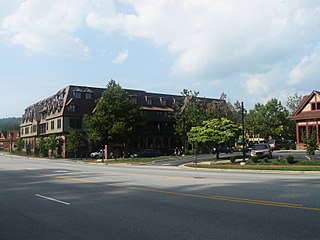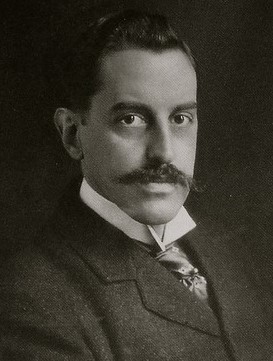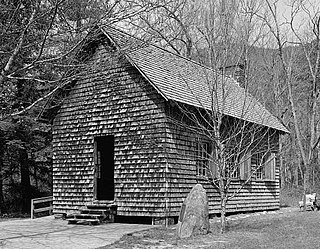
The Vanderbilt family is an American family who gained prominence during the Gilded Age. Their success began with the shipping and railroad empires of Cornelius Vanderbilt, and the family expanded into various other areas of industry and philanthropy. Cornelius Vanderbilt's descendants went on to build grand mansions on Fifth Avenue in New York City; luxurious "summer cottages" in Newport, Rhode Island; the palatial Biltmore House in Asheville, North Carolina; and various other opulent homes. The family also built Berkshire cottages in the western region of Massachusetts; examples include Elm Court.

Biltmore Estate is a historic house museum and tourist attraction in Asheville, North Carolina. Biltmore House, the main residence, is a Châteauesque-style mansion built for George Washington Vanderbilt II between 1889 and 1895 and is the largest privately owned house in the United States, at 178,926 sq ft (16,622.8 m2) of floor space and 135,280 sq ft (12,568 m2) of living area. Still owned by George Vanderbilt's descendants, it remains one of the most prominent examples of Gilded Age mansions.

Biltmore Village, formerly Best, is a small village that is now entirely in the city limits of Asheville, North Carolina. It is adjacent to the main entrance of the Biltmore Estate, built by George W. Vanderbilt, one of the heirs to the Vanderbilt family fortune. Once known as the town of Best, George Vanderbilt created this village as a "company town" for the estate workers. The community was planned and designed to reflect the qualities of an English country village. The village had its own church, which is still in operation today as the Cathedral of All Souls, an Episcopal cathedral. The village also had a hospital, shops, a school, a train station, and other services available.

George Washington Vanderbilt II was an American art collector and member of the prominent Vanderbilt family, which amassed a huge fortune through steamboats, railroads, and various business enterprises. He commissioned the construction of a 250-room mansion, the largest privately owned home in the United States, which he named Biltmore Estate.

Pisgah National Forest is a National Forest in the Appalachian Mountains of western North Carolina. It is administered by the United States Forest Service, part of the United States Department of Agriculture. The Pisgah National Forest is completely contained within the state of North Carolina. The forest is managed together with the other three North Carolina National Forests from common headquarters in Asheville, North Carolina. There are local ranger district offices located in Pisgah Forest, Mars Hill, and Nebo.

Edith Stuyvesant Vanderbilt Gerry was an American philanthropist and wife of George Washington Vanderbilt II and Peter Goelet Gerry, a United States senator from Rhode Island.
William Amherst Vanderbilt Cecil was the operator of the Biltmore Estate through his company, The Biltmore Company.
George Henry Vanderbilt Cecil was an American businessman who was the owner and chairman of Biltmore Farms.

Founded in 1897 by George Washington Vanderbilt II, Biltmore Farms has evolved from one of the Southeast's largest independent dairy producer to a community development firm. Son of William Henry Vanderbilt and grandson of Cornelius Vanderbilt, George W. Vanderbilt pioneered sustainable land-use practices when he moved from New York to the Southern Appalachian Mountains near Asheville, North Carolina, where he built his famed Biltmore Estate, America's largest residence.

The Omni Grove Park is a historical resort hotel on the western-facing slope of Sunset Mountain within the Blue Ridge Mountains, in Asheville, North Carolina. This hotel was visited by various Presidents of the United States mentioned below.

Fred Loring Seely was an American newspaperman, chemist, inventor and philanthropist.
Carl Alwin Schenck was a German forester and pioneering forestry educator. When Schenck came to the United States to work for George W. Vanderbilt at the Biltmore Estate, he became the third formally trained forester in the United States. He established and operated the Biltmore Forest School, the first forestry school in North America, on Vanderbilt's property.

The Biltmore Forest School was the first school of forestry in North America. Carl A. Schenck founded this school of "practical forestry" in 1896 on George W. Vanderbilt's Biltmore Estate near Asheville, North Carolina. The school grounds are now part of Pisgah National Forest in Transylvania County, North Carolina as the Cradle of Forestry in America, a 6500-acre historic site which features exhibits about forestry and forest conservation history.

The Cathedral of All Souls, also referred to as All Souls Cathedral, is an Episcopal cathedral located in Asheville, North Carolina, United States of America. All Souls was built by George Washington Vanderbilt II, the grandson of railroad baron, Cornelius Vanderbilt, in 1896, to serve as the local parish church for Biltmore Village, which had been developed near his Biltmore Estate. The Right Reverend José Antonio McLoughlin is the current bishop seated at the cathedral.

Cornelia Stuyvesant Vanderbilt, later Cecil, later Bulkely-Johnson, later Goodsir was an American born heiress and member of the Vanderbilt family who inherited the Biltmore Estate. She was known for her eccentric behavior.
Richard Sharp Smith was an English-born American architect, noted for his association with George W. Vanderbilt's Biltmore Estate and Asheville, North Carolina. Smith worked for some of America's important architectural firms of the late 19th century—Richard Morris Hunt, Bradford Lee Gilbert, and Reid & Reid—before establishing his practice in Asheville. His most significant body of work is in Asheville and Western North Carolina, including dozens of buildings that are listed on the National Register of Historic Places or are contributing structures to National Register Historic Districts.

Biltmore Industries, Inc., also known as Biltmore Homespun Shops, is a historic industrial complex located adjacent to the Omni Grove Park Inn in Asheville, Buncombe County, North Carolina, now known as Grovewood Village. Biltmore Industries was started by Eleanor Vance and Charlotte Yale, missionaries who moved to Asheville, NC in 1901. The complex of seven buildings were built about 1917 by Fred Loring Seely, and are constructed of hollow ceramic tile with stuccoed exterior wall surfaces. The buildings are The Eleanor Vance Building (1917), Charlotte Yale Building (1917), Carding and Spinning Building (1917), (Former) Weavers' Building (1923), Boiler House (1917), Gatehouse, and Guardhouse (1917). The complex produced high-quality crafts and fine hand-woven wool cloth. The property was listed on the National Register of Historic Places in 1980.

Graylyn Estate, or Graylin, is a historic estate located in Winston-Salem, Forsyth County, North Carolina. It was listed on the National Register of Historic Places in 1978. The construction of the Norman Revival style mansion began in 1928. Associated with the house are a number of contributing outbuildings including a garage-guest house and "farm" complex. Today, Graylyn estate is used as a conference center and hotel. It is currently a member of Historic Hotels of America, the official program of the National Trust for Historic Preservation.

John Francis Amherst Cecil was the first secretary of the British Embassy, Washington, known for his marriage to Cornelia Stuyvesant Vanderbilt.














